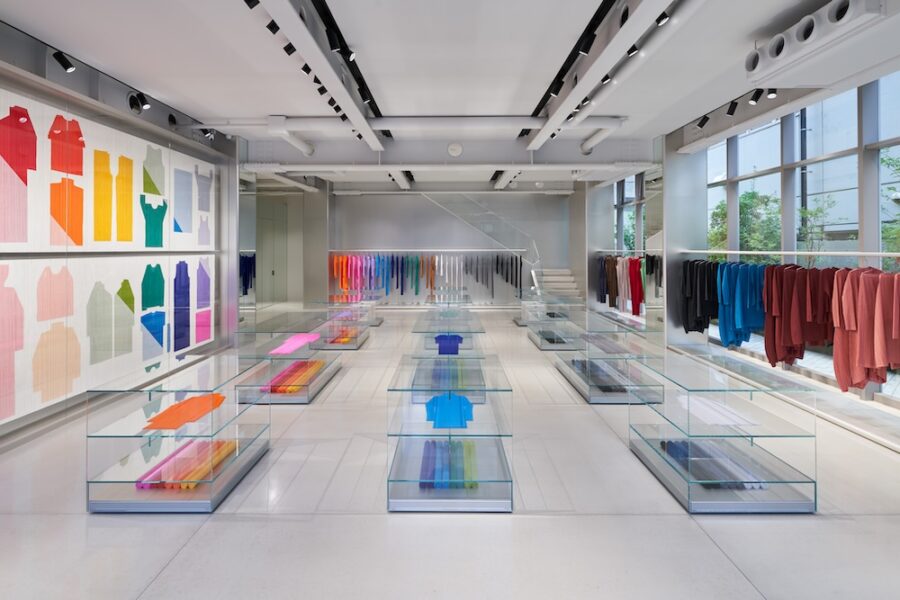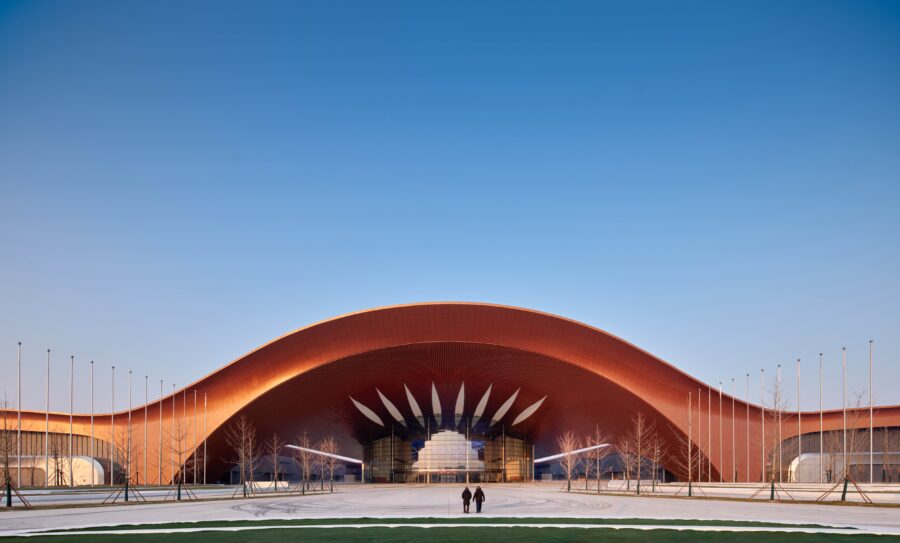
CULTURE


© Mario Wibowo

© Mario Wibowo
インドネシアのジャカルタに建つ〈アルマ・スプリット・ガーデン(Aruma Split Garden)〉は、レストランやバーといった複数のテナントを有する複合施設であり、マルチレベルの建物に自然を取り込むことを目的とした建築です。
スプリット・レベル(スキップフロア)の構造デザインが地上から屋上へと利用者の体験をシームレスにつなぎ、空間の間に庭園を設けることで、視覚的な楽しさとユーザー・エクスペリエンスも向上しています。
インドネシアという開発の進む発展途上国において、持続可能性を組み込んだ商業施設をさまざまな場所に分散させることにコミットする設計事務所 RAD+ar(Research Artistic Design + architecture)が設計しました。
RAD+arの関連記事はこちら
(以下、RAD+arから提供されたプレスキットのテキストの抄訳)

© Mario Wibowo

© Mario Wibowo
自然環境と融合したマルチレベルの商業空間
地価が上昇する中、〈アルマ・スプリット・ガーデン〉は、比較的コンパクトな敷地面積で自然を建築環境に取り込みながら、複数のテナントが入居する複合施設内に明確なゾーンをつくり出し、スプリット・レベルのデザインがどのように進化できるかを研究するためにつくられた。
デザインは、屋根、ファサード、壁、斜めに張り出した構造、家具などの要素を取り入れ、商業エリアの熱帯環境と調和する現代的なデザインとなっている。建築と空間には、自然光、緑、自然の眺め、自然素材、その他の感覚的な体験といった要素が取り入れられている。

© Mario Wibowo

© Mario Wibowo

© Mario Wibowo
地上から屋上へと利用者の体験をシームレスにつなぐ構造デザイン
建物は、裏側の緑地を保全するために南北方向に設計されている。 この設計手法は、2本の大木をつなぐ風の通り道をつくることで、空間体験を拡張することを目的としている。 しかし、緑地を犠牲にするわけにはいかないため、マルチレベルの商業スペースを最適化することが課題となった。
この課題を解決するために、構造的な要素をデザインに組み込むこととした。 1階にはレストラン、中2階にはバー、そして屋上にはビアガーデンを設けることで、前庭からシームレスに移行し、3つのテナントを斜めにつなぐループが生まれた。 このように、異なる空間体験や特徴を統合することで、まとまりのあるデザインを実現した。

© Mario Wibowo

© Mario Wibowo

© Mario Wibowo
さらに、異なる素材や構成要素をスムーズかつシームレスにつなげるため、空間と空間の間に庭園を設けた。これにより、視覚的に楽しいデザインが生まれるだけでなく、全体的なユーザー・エクスペリエンスも向上する。
材料の使用量とエネルギー消費量を最小限に抑えるため、構造要素の耐荷重を慎重に検討し、効率的な建設技術を用いることで構造設計を最適化した。さらに、環境への影響や特性を考慮し、持続可能な仕上げ材を選択した。最適な統合を目標とし、持続可能性を考慮することで、デザインは機能性、美観、環境への責任のバランスを達成した。

© Mario Wibowo

© Mario Wibowo
設計で目標とした最適な統合とは、建物内のさまざまな要素や構成要素をシームレスに融合させることを目指す設計アプローチであり、機能性、審美性、環境的背景、持続可能性、ユーザーエクスペリエンスといったさまざまな側面との間に調和のとれた関係を生み出す。
このアプローチを採用することによる目標は、すべての要素が協力し合うことで空間全体の質と効果を高める、首尾一貫したバランスの取れたデザインを達成することである。

© Mario Wibowo

© Mario Wibowo
〈アルマ・スプリット・ガーデン〉は、RAD+arが手がける多くの商業プロジェクトの中で、持続可能性を考慮した施設をさまざまな場所へ分散させるというコミットメントを示すための取り組みの1つである。これにより、インドネシアのような発展途上国における多くのデベロッパーを、このような取り組みに倣うよう刺激することを期待している。
また、建物の利用者に、設計に組み込まれた持続可能な機能や特徴について伝えることで、責任ある行動や持続可能な生活へコミットしてもらうことも期待している。

© Mario Wibowo

© Mario Wibowo

© Mario Wibowo

© Mario Wibowo

© Mario Wibowo

© Mario Wibowo

© Mario Wibowo

© Mario Wibowo

© Mario Wibowo

© Mario Wibowo

© Mario Wibowo

© Mario Wibowo

Model

Diagram

1st Floor Plan

2nd Floor Plan

Roof Plan

Section

Section

Section

Section
以下、RAD+arのリリース(英文)です。
Project Name: Aruma Split Garden
Office Name: RAD+ar
Office Website: www.radarchitecture.net
Social Media Accounts: @radarchitects (IG)
Firm Location: Jakarta & Bali, Indonesia
Completion Year: 2024
Gross Built Area (m²/ ft²): 2500 m²
Project Location: Jakarta
Program / Use / Building Function: Restaurant / Bar
Lead Architects: Antonius Richard & LeviandriProject DescriptionIn the challenge of rising land values, the Split garden was created as a study of how split-level design can evolve, creating distinct zones within a compound of multiple tenants while incorporating nature within the built environment in a relatively compact footprint. The iteration of the design reflects RAD+ar’s search for significance and evolving roles in optimizing circulation.The design incorporates elements such as roofs, facades, walls, diagonal cantilevered structures, and furniture elements, all in a contemporary design that blends with the tropical surroundings of the commercial area. Integration elements like natural light, greenery, views of nature, natural materials, and other sensory experiences are incorporated into the buildings and spaces.The design of the building was oriented north-south to preserve the existing greenery in the rear garden. This design approach aimed to expand the spatial experience by creating a wind tunnel that connects the two giant trees at both ends. However, this situation posed a challenge in optimizing the multi-level commercial spaces without sacrificing any greenery.To address this challenge, the structural elements were integrated into the spatial planning of the design. This allowed for a seamless transition from the front garden, diagonally creating a loop connection for three tenants: restaurants on the ground floor, a bar in the mezzanine space, and a beer garden in between spaces extended to the rooftop. This integration of different spatial experiences and characters within the development ensured a cohesive design.In addition, gardens were appreciating between spaces to ensure smooth and seamless connections between different materials and components. This not only created a visually pleasing design but also enhanced the overall user experience.To optimize the structural design, the goal was to minimize material usage and energy consumption. This was achieved by carefully considering the load-bearing capacity of the structural elements and using efficient construction techniques. Furthermore, sustainable finishing materials were chosen, taking into account their environmental impact and attributes.By targeting optimal integration and considering sustainability, the design achieved a balance between functionality, aesthetics, and environmental responsibility.Targeting optimal integration implemented in design refers to a careful and thoughtful design approach that aims to seamlessly blend different elements and components within a building. This approach creates a harmonious relationship between various aspects such as functionality, aesthetics, context, sustainability, and user experience. The goal is to achieve a cohesive and balanced design where all elements work together to enhance the overall quality and effectiveness of the space.Aruma split garden is one of many iterations from RAD+ar to showcase their commitment on decentralizing sustainability amongst many commercial projects that might inspire many developers in developing country such as Indonesia to follow. Promoting sustainability by educating building occupants and users about the sustainable features and practices incorporated into the design that can encourage responsible behavior and a commitment to sustainable living.
RAD+ar 公式サイト
https://radarchitecture.net










